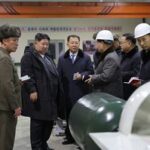4 to 5 time of cruise missile provocations within a recent month
Strategy to maximize security threats ahead of the general elections in April

North Korea is escalating tensions on the Korean Peninsula by continuing its 11th military provocation this year. North Korea is focusing on cruise missiles, mainly while it is working to secure operational capabilities through a mix-and-match approach using various weapon systems such as ballistic missiles, cruise missiles, underwater weapon systems, and artillery.
North Korea has carried out five cruise missile provocations in the past month. North Korea fired several new Bulhwasal-3-31 strategic cruise missiles from around Pyongyang to the West Sea on the 24th of last month.
The Bulhwasal-3-31 model is an improved version of the existing strategic cruise missile, Hwasal-1·2. The 31 attached to the name is interpreted as meaning that it can carry the Hwasan-31 tactical nuclear warhead that North Korea revealed last year.
On the 28th, just four days later, North Korea demonstrated its ability to launch the Bulhwasal-3-31 from a submarine near Sinpo, South Hamgyong Province. If it was launched from the ground to the sea on the 24th, it verified the performance of the Submarine Launched Cruise Missile (SLCM) on the 28th.
On the 30th, it fired the existing Hwasal-2 to the West Sea. North Korea claimed that it did not test launch the Hwasal-2 that day but conducted launch training. It suggested that the Hwasal-2 has moved beyond the development stage and can be deployed in actual combat.
In February, North Korea claimed to have tested a cruise missile super-large executive branch (warhead) power and a new anti-aircraft (ground-to-air) missile test launch from the West Sea on the 2nd. It was a kind of showcase that performance improvements had been made enough to carry the Hwasan-31 tactical nuclear warhead. It is known that our military’s detection assets detected the cruise missile for a shorter flight time and distance than before.
North Korea also conducted a review shooting test of the new ground-to-sea missile (ground-to-ship missile) Badasuri-6 in the East Sea on the 14th. Badasuri-6 appears to be developed based on the anti-ship cruise missile North Korea unveiled in 2015 and 2017. It is also called the North Korean version of Uran, which was made by imitating the old Soviet (Russian) cruise missile Uran (Kh-35). It is presumed that the development has been completed as the North Korean state-run media Korean Central News Agency reported that “Chairman Kim Jong Un was delighted with the review shooting test.”
It is analyzed that North Korea is actively using cruise missiles in recent provocations because cruise missiles are not included in the UN Security Council sanctions against North Korea. The UN Security Council resolution prohibits launches using ballistic missile technology but considers cruise missiles as a right of self-defense.
However, unlike ballistic missiles, cruise missiles fly in low orbit, making them relatively difficult to detect. It is said that our military may have difficulty intercepting them in an emergency.
North Korea is expected to continue its military provocations as a strategy to maximize security threats ahead of the general elections in April. Kim Sung Han, former head of the National Security Office of the Presidential Office, said in a podcast at the Center for Strategic and International Studies (CSIS), a think tank in Washington, on the 13th (local time), “There is a possibility of committing a local provocation that only reacts to Korea without threatening the United States in front of the general elections.”















Most Commented